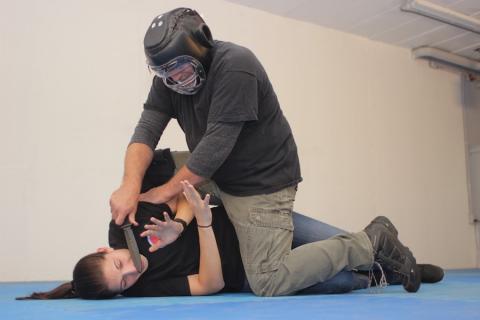The Fight
January 18, 2021
Fights are not static. Things move. People move. Bear-hugs and headlocks and all that stuff happen sometimes in a fight, but they are transitional actions. You do not get bear-hugged just to be held (except by bouncers). A Threat wraps his big arms around you from behind either to pick you up and shake you (disorienting and intended as an intimidating show of strength) or to drive you into a wall. Maybe to throw you over a balcony. If you practice technique-based defense, will they work if the Threat refuses to stand there? If he is using that headlock to slam you from wall to wall?
The Lowest Level of Force
December 7, 2020
The Records area at Rusafa Prison Complex in Baghdad is enclosed by a chain-link fence and was almost always crowded. It’s a stressful place, with inmates being processed in and out, Iraqi military, police, corrections, advocates, politicos, and sometimes families of the convicts are present and a small handful of American advisors.
Simple Drills Worth Knowing
January 30, 2017
The following are important things, some little, some major, that lend themselves well to simple drills or exercises. Backing up is almost never the answer. Unless you are excellent at reading and remembering tactical terrain, you might not know what or who is behind you.
Evaluating Drills—Part 2
October 31, 2016
I get especially annoyed with weapons. Unarmed defense against a weapon sucks. Never, ever, ever practice dying and do not train to be killed. The stakes are too high to blindly imprint a habit, even a habit as simple as handing a weapon back once you have disarmed someone.
Evaluating Drills—Part 1
October 24, 2016
I'm not a big fan of most drills. There is a fine line, but conditioned reflexes are crucial in a fight and habits will get you killed. Conditioned reflexes are things you do without thinking about it. They are essentially trained flinch responses. If something suddenly comes at your eyes you WILL do something: block, move your head or, at the very minimum, blink.
Comments on Hojo Undo from Okinawan Karate Masters
-
December 27, 2010
Since I began traveling to Okinawa in 1984, I have been privileged to meet many great karate teachers over the years. Some have had a worldwide following, while others have not, but the majority of them have had something in common—their sincere love for the fighting arts of their homeland and their willingness to share what they know.
About Junbi Undo—Part 2
-
August 22, 2010
"Lift things properly, hit things with care", this maxim should be at the forefront of your mind when embarking upon the study of traditional Okinawan hojo undo. Find your limit with each tool and exercise, and then carefully and methodically push that limit further and further. In doing so you will learn much about yourself and who you really are.
About Junbi Undo—Part 1
-
August 16, 2010
In an Okinawan karate dojo, warming-up exercises are known as junbi undo, preparation exercises. Within many Western schools of karate today, the warm-up exercises often have little in common with the mental activity that follows, neither do they always relate particularly well to the physical demands placed upon the specific muscle groups and tendons throughout the body that are about to be used in the karate training itself.
The Seven Aspects of Self-defense
-
January 13, 2010
The following article is an excerpt from an upcoming book by Rory Miller, tentatively titled 7. It will explore the seven aspects that are critical to self defense, giving you a few hints on staying alive, or if you teach self-defense, some critical information you can pass along to your students.
¿Golpeas al objetivo?
-
December 14, 2009
Nunca dudé, al ponerme frente a Kanazawa sensei, que iba a "enchufarme". Pero tenía la absoluta certeza de que no iba a hacerme daño.
Are you hitting the target in Karate?
-
November 30, 2009
There was never a doubt in my head when I lined up to face Kanazawa sensei, I knew he was going to 'plug' me.
Remembering Chojun Miyagi
-
November 11, 2009
Among the huge number of so-called karate styles in the world these days, all can be traced back to the island of Okinawa, the largest island in the Ryukyu archipelago that stretches from the southern coast of Japan to the northern tip of Taiwan.
Hojo Undo: Traditional Karate’s Forgotten Training Methods
-
September 9, 2009
In an age where karate training is often viewed as a family pastime for some or a career path for others, many of the older and more traditional forms of training have slipped from use, replaced in many cases by a quest for physical entertainment.
Big Rocks: The Hidden Values of Traditional Karate
-
August 13, 2009
A philosopher and teacher of the ‘Way’ began addressing his students. He produced, from behind a screen, a large glass container and a box of fist-sized rocks. After a few moments of carefully placing the rocks into the glass container, he came to a point where no more would fit. He then turned to his students and asked: “Is it full?”
Meditations on Violence
-
May 22, 2008
People are weird. They have an almost infinite ability to learn and communicate. At the same time, this amazing ability is used as much for fantasy and entertainment as it is for information and survival. Take, for example, the rhinoceros and the unicorn.
- « first
- ‹ previous
- 1
- 2
- 3













